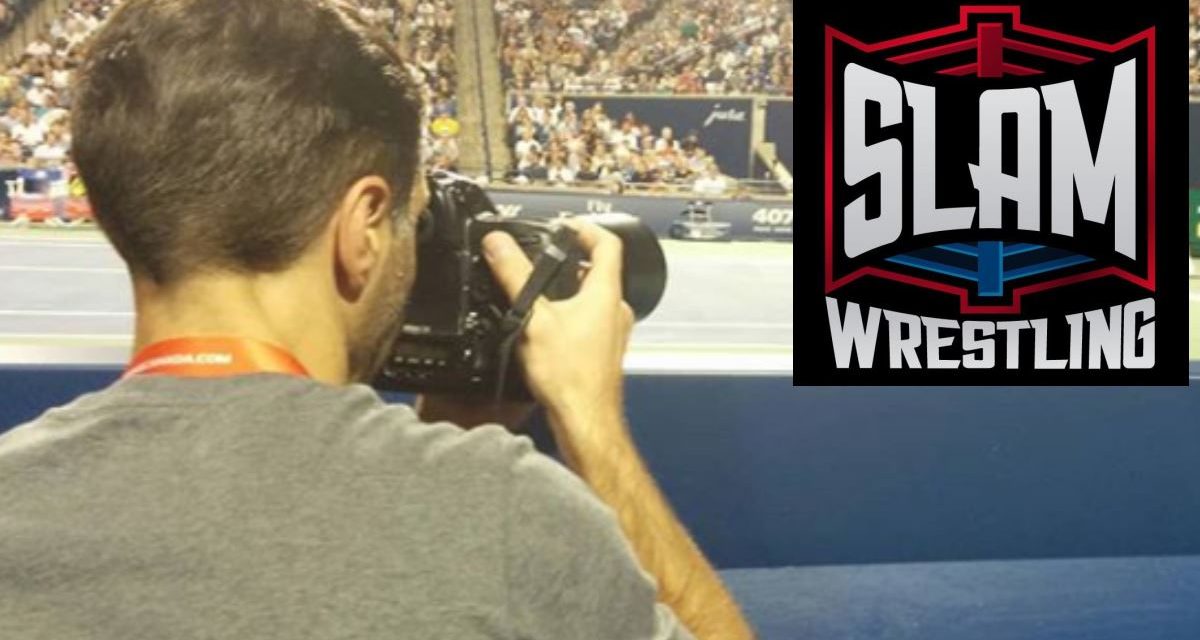In the 1980s and early 1990s, the WWE featured some of the most memorable characters of all time. Each personality had a unique look and style that separated them from the rest. Tom Buchanan was the WWE’s staff photographer during this era, and as such was the man responsible for capturing iconic images of all of them. He shared with SLAM! Wrestling his story of his time behind the lens.
It’s ironic that the man who played such a key role in the company for nearly 15 years never was, and still isn’t, a big wrestling fan. Rather, it was his photojournalism interests, and the offer from a previous employer, that brought him into the WWE.
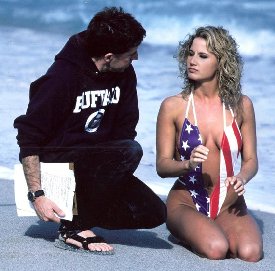
Tom Buchanan during a Sunny photo shoot. All photos courtesy Tom Buchanan
“I shot for community newspapers and wire services as a freelance photographer through high school and college, then took successive staff photographer jobs at three daily newspapers in upstate New York,” Buchanan began.
“Steve Taylor had hired me for my first full-time photography job at the Auburn Citizen in 1981, and he later on he took the staff photographers job with WWF when the company launched Victory magazine, (which soon became WWF Magazine) in the early 1980s. He hired me to do freelance photography for WWF beginning with WrestleMania in 1985. (I did one) show in Toronto before WrestleMania so I could get my timing down, then it was onto the big event.”
After a couple of years freelancing, Buchanan was offered a full-time job with the company. He originally wasn’t interested in taking on the job, but ended up accepting the deal — and staying with the company until 2001.
“WWF offered me a full-time staff job three times, but I turned them down twice, and reluctantly accepted the third offer. I enjoyed working my staff job as a serious photojournalist, and then doing the WWF gig on weekends and holidays, and didn’t want to give up that lifestyle. Plus, the Observer Dispatch had offered me a transfer to a photo editor slot at USA Today if I remained in Utica for another year. The wrestling business was growing to the point where WWF really needed a second full-time shooter, and if I declined the third offer they would hire somebody else. I actually took the job expecting to stay for a year and then return to journalism — specifically USA Today or another Gannett product — but I stuck around WWF for about 14 years.”
In that time, as the Chief of Photography, he traveled the world, lived a life on the road with the boys, and was there for the company’s transformation into a global multinational public company.
It wasn’t quite that easy, Buchanan remembered. Initially, some of the wrestlers were reluctant to let in this outsider, who many feared would be an office “stooge.” Eventually, though, he managed to work his way into the fold. Part of the acceptance, he believes, stemmed from his first major road trip with the company, when he made a positive impression with Vince McMahon.
“It was on my first cross-country trip with the company in 1987. It was my first encounter with traveling as part of the whole production. We were on a wide-body plane flying out. At some point on the trip, somebody dropped a black mens’ shoe in my lap. I don’t know who or what it was all about, but whatever. A little while later, Vince McMahon comes by and drops a white ladies’ shoe in my lap. Now I’m scratching my head. I hold on to them for a little while, figuring out what this all meant. After a while, I’m not sure why, but I threw the mens’ shoe into the bathroom. As we’re coming into land, the flight attendant comes on the PA, and announces that if you have lost a black mens’ shoe to please identify yourself, or if you have found a white womens’ shoe, it has been lost. The plane erupts in laughter, all the crew and production, because they know what’s up and I still don’t. It’s explained to me that if you’re traveling with the company, you never fall asleep, because somebody will steal your shoe. And that’s exactly what Vince did. I ended up taking the shoe to the Saturday Night’s Main Event show, and I put it on Vince’s chair. He came up to do the live show, and there’s the shoe sitting on his chair, and he falls to the floor laughing. I picked up the shoe after the show, and ended up carrying it with me in one of my production cases for the rest of my time there, to remind me that I wasn’t working for a normal company.”
Pranks involving the Chairman weren’t necessarily uncommon, he said. Though there was always some trepidation when dealing with the boss, for fear of crossing the line.
“In the very early days, he would fire you for wearing the wrong coloured shirt. Howard Finkel was probably fired more than anyone else in the company. But he just refused to leave,” he laughed. “He’d show up for work the next day, and most of the time it worked out.”
Over time, though, Buchanan got comfortable interacting with Vince, even if the circumstances weren’t necessarily comfortable.
“There were several points where the folks I worked with in the office were very upset with what was going on on TV, and they weren’t comfortable mentioning it, so they asked me to. The one I really remember was during the Goldust period. I took that one to Vince, and I think he appreciated it. He was willing to listen to my complaints. You never know which one may be the final straw, but it never was.”
“It’s tough at first, because he is the boss, he is the owner, and it can be hard to recognize that he is just a person. In general, people weren’t very comfortable with him at the start, but got comfortable later on. Once he got comfortable with you, he was a very comfortable person to be around. He would relax and hang out, he ribbed and he took ribs.”
In terms of work, Buchanan wore many, many hats in his role. Responsibilities included co-ordinating still photos at all live events, managing freelancers, producing all location photo shoots, managing the corporate photo studio, co-ordinating photos for the magazines and website, overseeing the set-up for TV lights — including climbing up trusses and manually pointing them.
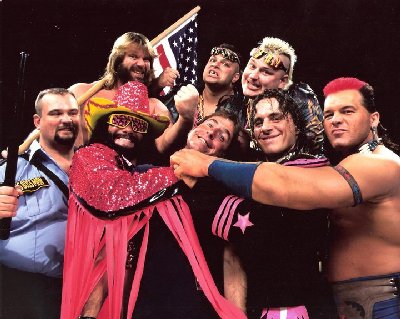
Tom Buchanan is mugged by WWF superstars during a 1993 photo shoot.
“In the early days, I was responsible for my own editing. I was a key player in all the publication story-budgeting meetings, and often met with other executives to assist them in planning their photography needs. Keep in mind WWF became a billion dollar multinational publicly traded corporation that relied on photography as one of the cores of the intellectual property development. I was always being pulled in many directions.”
The job evolved significantly throughout his tenure with the company.
“In the early years I mostly shot action, so I was simply given a list of talent we needed images of based on the status of the archive. That direction came from the photo editor, or the magazine editor. By the ’90s I was deeply involved in studio and feature photography. That was often directed by magazine staff/editors, or company art directors working on a specific project. Equally often I was simply tasked with shooting photos of a talent for a feature story, and I had to come up with the creative. Sometimes the talent would suggest something, and sometimes Vince might have an idea and suggest it.”
One major development for the company — and one in which Buchanan played a huge role — was the introduction of the Divas program. He gives all credit to Sunny for coming up with that idea.
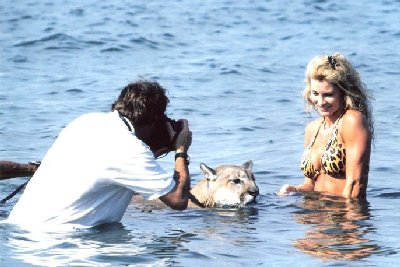
Tom Buchanan has the tough job of wrangling a big cat and Sable.
“She was part of the Body Donnas,” he said, “working as Chris Candido’s valet. And she was very frustrated in that role. She wanted to do a lot more. She asked me if I would shoot some sexy pictures of her. So we set up a time before one of the house shows. I told her to bring some sexy clothes to a show in Rochester, and before the show we took some photos right outside the arena. We had just started a program with America On-Line, so there was a spot to put the pictures up. We put them online, not knowing what would happen, and the downloads went crazy. That got Vince’s attention really fast, because we got paid based on connect time — the more downloads, the more connect time. Vince started to expand on this a bit, and we did a bunch of sexy shots around his house. I did a bunch of those shoots around the house, and he liked the way I put them together. We ended up doing another one in Miami Beach, primarily for still photography, but also took along a freelance video crew. And we ended up producing that video, and that really made the project take off. And from there, the Divas were born. Sunny was the only one originally. We wanted Sable to be a part of it, but she wanted nothing to do with it originally. But later on, she came to me and asked to be part of it. It was really Sunny’s creativity and willingness to push the envelope that got the Diva program going.”
That is just one of the many initiatives he remembers fondly, and notes Sunny as being one of his favourite people to work with. He is also complimentary towards The Rock, Steve Austin, Bobby Heenan (“one of the best and brightest Superstars in my book”), George “The Animal” Steele (“because of his in-ring character and his real-life character … he was always a stand-up person who really helped me understand the business”), Jerry Lawler, Randy Savage, Bret Hart (“I really liked Bret as a person, but didn’t especially enjoy shooting him because his character was so dry”), Hacksaw Jim Duggan, Lord Alfred Hayes, and Mick Foley.
On the other hand, he was not particularly fond of Vader (Leon White), and shared a story from a tour of Kuwait that was one example as to why that is.
“I (was doing a photo shoot at) a Burger King with him, Owen Hart and someone else I can’t remember. What was supposed to happen at those events is that there were supposed to have a table with security and two exits so that they could get people in and out quickly. We get dropped off at this Burger King, and we have only one security guy and that’s it. No table, no additional security, and that’s it. There are hundreds of screaming fans there. And then our limo takes off, leaving just the four of us there — five, counting the one security person. The security person and I go into the back and get a couple of tables in the back of the restaurant. We figure we’ll do the autographs there, start the session, and call the limo back to get us, because the crowd is just crazy at this point. The security person secures a bathroom, and that’s going to be our safe room, in case things get out of hand with the crowd. There’s a window in there in case we have to break the glass and get out. I’ve got the talent signing autographs, and the plan is to do this only as long as until the limo gets back. Vader decides that (he’s had enough), and gets up from the table and storms to the front of the building, screaming all the way, pushing people out of his way. As he’s going, kids are being slammed into these thick glass partitions between tables. The glass is shattering apart, glass is flying, kids are getting cut and screaming, and there’s Vader just pushing his way through. As this happens, the limo comes back. I get the two talents that are left — Owen and whoever else was there and get them into the limo. I go back to get Vader, go around to the back of the building and pull him to get him into the limo. He gets to the limo, jumps in, slams the door and takes off. He leaves me standing there stranded, with hundreds of irate fans. That was Vader. I was not a fan.”
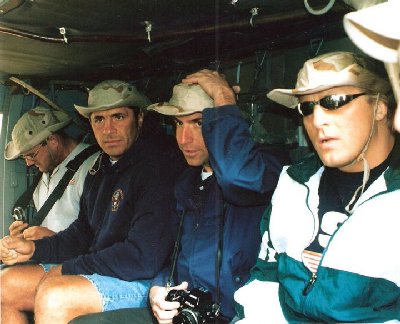
Tom Buchanan hangs on to his hat while traveling in Kuwait in 1997 with Davey Boy Smith, Bret Hart and Owen Hart.
As harrowing as that story was, it wasn’t the worst day of Buchanan’s time with the company. For that, he looks back to one of wrestling’s biggest tragedies, the night Owen Hart fell to his death.
“I can say with certainty that it remains the worst day of my life,” he reflected. “I was working at ringside that night in Kansas City. I wasn’t paying a huge amount of attention at that point, because we were dark. I was posted where I was supposed to be positioned ringside, to the right side of the hard cameras. I had a freelancer on the left side, and because we were dark, I had gone around to his side to have a quick conversation with him. I was walking back when Owen fell, so I wasn’t really looking at it. I initially didn’t know what had happened, but immediately figured it out when I saw a police officer jump into the ring.”
Buchanan also played a key role for the company in the aftermath of the event.
“At the end of the event, I was assigned to observe the police inspection and photograph the rigging, as well as talk with the rigger who produced the failed stunt. I ended up driving back to the police station and photographing the harness, and then drove halfway to the next town (St. Louis) before stopping. The next morning I swung by a marine supply store to buy a shackle and snap shackle so I could explain to Vince how the accident happened, and then continued on to the TV event. When we wrapped up in St. Louis I was tasked with bringing Owen’s cape back to Stamford and photographing it under the observation of the in-house legal team. I later used the sample snap shackle in my Stamford studio to simulate how the accident might have happened, and developed a theory that differed from the initial police model but matched a later theory advanced by Martha Hart in her book Broken Harts.”
One might wonder how that falls into the job description, but as was said before, Buchanan wore many hats in his role.
“I was the staff photographer for the company, a billion-dollar multi-national company. I covered whatever needed to be covered. That might include taking passport pictures for the guys, it might involve taking pictures of the building. We’d had a few industrial accidents before that, and I had been asked to shoot pictures of those. It was part of the job. I was responsible for every single image that we produced, for every application, all over the world.”
Which didn’t mean that he didn’t have a chance to have some fun, though. Despite not being a wrestling fan going in, Buchanan did gain an appreciation for good work and good workers while shooting his subjects.
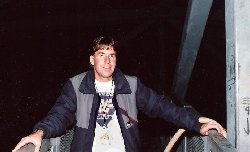
Tom Buchanan is way up high in the catwalk at Toronto’s SkyDome (now called the Rogers Centre).
“WrestleMania 3 was among the best nights just ’cause of the crowd. There was a Shawn Michaels/Razor Ramon ladder match at WM in MSG that was killer. The Bret Hart/Davey Boy Smith SummerSlam match in Wembley Stadium was wild. The Bret/Shawn Iron Man match at WrestleMania 12 was amazing, both for the match and the professionalism both men displayed in spite of personal animosity. The Bam Bam (Bigelow) versus L.T. (Lawrence Taylor) match at Mania XI was crazy because LT had originally not been into the project, but when he became engaged he kicked some serious ass, plus Bam worked his tail off to make LT look good … that match makes it to my top list because of the tremendous turn around on the part of LT, and the amazing job Bam did of getting him over.”
And the worst?
The introduction of the Gobbledy Gooker … the ridiculous psycho chicken,” he laughed. “I’ll never forget a matinée house match in Indianapolis that was so boring I leaned against the corner post with a camera in front of my face and feel asleep until the bell rang. It was a large crowd that day, but I don’t know if anybody in the house was paying enough attention to realize I was sleeping on the job. That one sucked. And once we had a truly horrible event in California — Fresno, maybe — one Super Bowl Sunday in which the house was damn near empty. It was what I called a McDonalds crowd ’cause we should have saved some money and just taken them all to McDonalds. George Steele was the agent, and he told me that was the kind of event he worried about because in the absence of crowd noise the top talent would work extra hard to get over, and there was an increased likelihood of injury. He was right … top talent did work extra hard when the shows were tough, and the bottom talent just phoned it in.”
Buchanan also took offense at some of the more questionable storylines of the company, like the afore-mentioned Goldust character.
“There was a nasty match in which Rick Rude and Jake Roberts battled, and at the end Rude won and grabbed Jake’s wife Cheryl and kissed her. The spot was first run in house shows, and I saw it at the Rosemont in Chicago. It was a horrible finish in which Rude forced his kiss on Cheryl who was resisting. It had the feel of a live rape in the ring, and the house was silently stunned. I voiced my displeasure to the agent that night, and to Vince a few days later. The spot was never done again in that way. There were a couple of other matches and spots that were really bad, and I very occasionally offered Vince my opinion, which I think he may have appreciated. Or maybe not.”
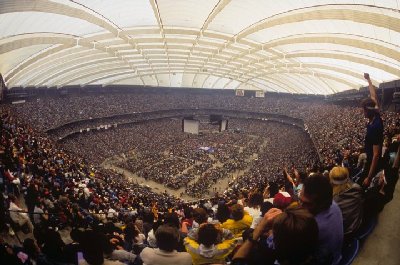
Tom Buchanan’s shot of the massive crowd at the Pontiac Silverdome for WrestleMania III.
The other unfortunate part of his ringside shooting was seeing serious injuries, though he noted that those were quite rare.
“It didn’t bother me all that much, with the exception of the accident that left Droz paralyzed, and to a lesser extent an accident in Tampa in which a ‘jobber’ was paralyzed in a spot gone bad with, I think, The Rockers. I was a couple of feet away when the Droz spot went bad, and knew instantly he was in serious trouble. In the case of the Tampa accident I was on the arena floor, but way in the back of the house and not paying any attention.”
Otherwise, the job had its share of ups and downs, just like it does for most people, albeit in a rather unique industry. That goes even so far as his departure from the company in 2001.
“I left because they told me I was leaving,” he said simply. “It’s hard to know why it happened, and the company never gave a reason, which was typical of organizational change. At the time business was suddenly slowing, and I had a capital request to build a new studio at a cost of something like $250,000, which raised eyebrows in the accounting department. After I left, the company slashed the new studio budget, farmed many of my responsibilities out to other departments, and then tried hiring a new staff shooter at half my salary. They weren’t successful in finding a shooter at that price point and left the job unfilled. So it may have been a purely financial decision.”
“There were probably internal political reasons for the change as well, most notably hostility from Stephanie McMahon who didn’t like me and at the time was flexing her muscles as a creative director. It’s also possible the change was due to something completely different. I’ll never know.”
Buchanan is philosophical about the release, noting that releases are nothing new for any company. Though he does admit it took him a bit off-guard at the time.
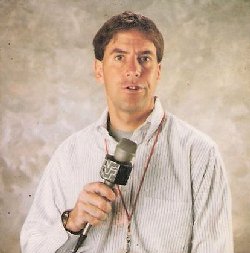
Tom Buchanan steps in front of the lens during a 1997 lighting check.
“I watched so many people just get thrown out the door for no good reason. But I thought that for whatever reason, I would have a different experience. But it didn’t happen that way. When the company was struggling financially, during the steroids scandal, the company probably shouldn’t have survived; it was being held together by smoke and mirrors. Linda (McMahon) called a meeting of all of us together in the television production facility and asked us to please stick by her, to do whatever we could to keep the company going and that she would take care of us. At that point, I had freelancers that didn’t want to work for me anymore because they were afraid they wouldn’t get paid. I made them the commitment that I would cover all of their expenses no matter what happened, even if it meant using my own money. I carefully tracked my credit ratings and my credit cards to make sure that I always had the money to pay them off. We got through it. The company never returned back to that point. We went from smoke and mirrors to a billion-dollar market cap. And Linda gave us nothing. That’s the point where I think I trusted them, I believed them, and I shouldn’t have. So if I had that part to do over again, I probably wouldn’t have. I believed in the product, I wanted us to succeed, and I did whatever I could to help them succeed.”
Since leaving the company, Buchanan hasn’t looked back — the last show he’s been to live was WrestleMania X8 in Toronto. Instead, he has focused on other interests, like skydiving, snowboarding, and fly-fishing. In his early 50s today, he lives in Vermont, teaching snowboarding in the winter and fly-fishing in the summer. He uses fly-fishing as a calming factor — he’s a confessed adrenaline junkie — and though it’s a relatively new hobby, he’s thrown himself completely into it. His book is about skydiving — JUMP! Skydiving Made Fun and Easy — was published by McGraw-Hill in 2003, and while it is out of print now, it is still available as an e-book from Amazon and other vendors.
Buchanan doesn’t often look back on his time in the WWF, nor does he really intend to. Other than a few pictures on his Facebook page, he has no plans to release any of the photos he took from that time, for example in a book.
“Technically, I own all the pictures I shot as a freelancer, so for the first two years of my working there. But after I started as a full-time employee, it became a work for hire arrangement so the company owns all the pictures. After I started working there, (I changed the arrangement) for freelancers, so that the company owns all of their pictures. But even the ones I technically own, they’re all in the company archives — I used to send the film to them directly when I was a freelancer. So I would have to fight the company to get them. But even still, I have no interest in doing a book. When I look back it’s always to understand where I am and how I got to this point, not to change the unchangeable.”
“I’m happy where I am. It was a great run, and I’m glad for every minute.”
